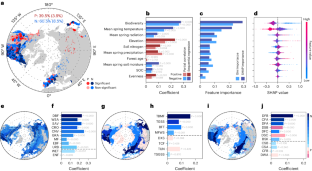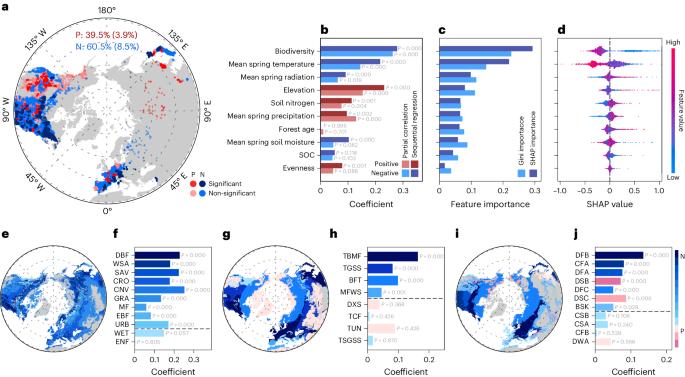生物多样性可缓冲春季展叶对气候变暖的反应
IF 29.6
1区 地球科学
Q1 ENVIRONMENTAL SCIENCES
引用次数: 0
摘要
了解春季落叶日期对温度(ST)的敏感性对于预测气候变暖的物候反应及其对全球生物地球化学循环的影响至关重要。虽然 ST 的变化已被证明受到当地气候适应性的影响,但生物多样性的影响仍然未知。在此,我们将 2001-2022 年间北半球 393,139 块森林调查地块与卫星得出的 ST 结合起来,结果表明生物多样性对 ST 的空间变化有很大影响,其重要性甚至超过了气候变量。树木的高度多样性极大地削弱了ST,这可能是由根深和土壤过程的变化驱动的。我们的研究表明,目前的地球系统模型无法再现观测到的 ST 与生物多样性之间的负相关关系,这对未来路径下的物候反应具有重要影响。我们的研究结果凸显了将生物多样性的缓冲作用纳入模型的必要性,以便更好地理解气候变暖对春季展叶和碳吸收的影响。本文章由计算机程序翻译,如有差异,请以英文原文为准。


Biodiversity buffers the response of spring leaf unfolding to climate warming
Understanding the sensitivity of spring leaf-out dates to temperature (ST) is integral to predicting phenological responses to climate warming and the consequences for global biogeochemical cycles. While variation in ST has been shown to be influenced by local climate adaptations, the impact of biodiversity remains unknown. Here we combine 393,139 forest inventory plots with satellite-derived ST across the northern hemisphere during 2001–2022 to show that biodiversity greatly affects spatial variation in ST and even surpasses the importance of climate variables. High tree diversity significantly weakened ST, possibly driven by changes in root depth and soil processes. We show that current Earth system models fail to reproduce the observed negative correlation between ST and biodiversity, with important implications for phenological responses under future pathways. Our results highlight the need to incorporate the buffering effects of biodiversity to better understand the impact of climate warming on spring leaf unfolding and carbon uptake. The authors combine 393,139 forest inventory plots with satellite data to understand the impact of biodiversity on the sensitivity of spring leaf-out dates to temperature (ST). They show that high diversity significantly weakens ST, a relationship that Earth system models largely fail to reproduce.
求助全文
通过发布文献求助,成功后即可免费获取论文全文。
去求助
来源期刊

Nature Climate Change
ENVIRONMENTAL SCIENCES-METEOROLOGY & ATMOSPHERIC SCIENCES
CiteScore
40.30
自引率
1.60%
发文量
267
审稿时长
4-8 weeks
期刊介绍:
Nature Climate Change is dedicated to addressing the scientific challenge of understanding Earth's changing climate and its societal implications. As a monthly journal, it publishes significant and cutting-edge research on the nature, causes, and impacts of global climate change, as well as its implications for the economy, policy, and the world at large.
The journal publishes original research spanning the natural and social sciences, synthesizing interdisciplinary research to provide a comprehensive understanding of climate change. It upholds the high standards set by all Nature-branded journals, ensuring top-tier original research through a fair and rigorous review process, broad readership access, high standards of copy editing and production, rapid publication, and independence from academic societies and other vested interests.
Nature Climate Change serves as a platform for discussion among experts, publishing opinion, analysis, and review articles. It also features Research Highlights to highlight important developments in the field and original reporting from renowned science journalists in the form of feature articles.
Topics covered in the journal include adaptation, atmospheric science, ecology, economics, energy, impacts and vulnerability, mitigation, oceanography, policy, sociology, and sustainability, among others.
 求助内容:
求助内容: 应助结果提醒方式:
应助结果提醒方式:


